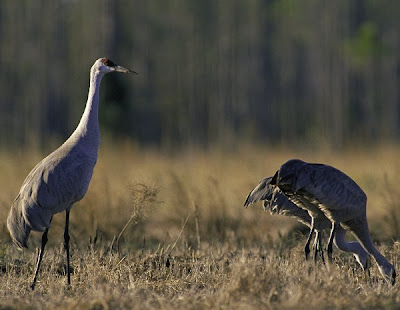Bird and birding news
- Renewable energy development poses some dilemmas for conservationists who may need to choose between low emission energy and wildlife protection. The problems are most apparent in the Southwest, where new transmission lines may run through important wildlife areas. Tall structures like transmission towers or wind turbines may scare away grouse and other prairie birds, even where birds are not killed in collisions.
- The world kakapo population is now up to 125 thanks to a successful breeding season that produced 34 chicks.
- Ethiopia's Sidamo Lark is on the brink of extinction. Only a few hundred remain and their habitat is shrinking.
- Migration flights of Old World Sylvia warblers could increase by as much as 250 miles due to climate change. Longer migrations would mean that birds would need to expend more energy and take more time to reach their breeding grounds.
- The carotenoids of red and yellow feathers are produced in a bird's liver rather than skin according to a study of Red Crossbills.
- Conservation groups are pushing the FCC to reduce bird kills at cell phone towers.
- There is talk of turning some foreclosed properties in Florida into parks.
- Oregon and Israel are trying to encourage their local barn owl populations as a rodent control measure.
- Salmonella outbreaks in Idaho and Minnesota are a reminder to keep bird feeders clean, especially with the weather getting warmer.
- There is now an online Sibley Guide at eNature.
- Cornell's new All About Birds was launched this week with 51 revised species profiles.
- Neotropical Birds launched with 25 new species profiles.
- Born Again Bird Watcher: Coins and Wishes
- Search and Serendipity: The *other* lords of the air
- Birdchick: A Minneapolis Sage Thrasher
- Bug Girl's Blog: Shiny! (not in a good way, alas)
- Mike's Birding & Digiscoping Blog: Clever Little Birds
- The Fish and Wildlife Service plans to reduce the designated critical habitat for Peninsular bighorn sheep by 55%.
- The EPA is going to require pesticide manufacturers to test whether their products interfere with human endocrine systems. Such chemicals may cause glands to produce abnormal hormone levels.
- The Clade, a new environmental website, is looking for contributors.
- Antarctica's Blood Falls contains microbes that were trapped in seawater under a glacier millions of years ago. The microbes generate energy through chemical reactions of sulfur and iron. (More on the bacteria.)
- Iceland is trying to turn carbon dioxide into rock by dissolving it in water and pumping it underground.




